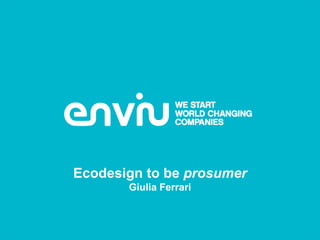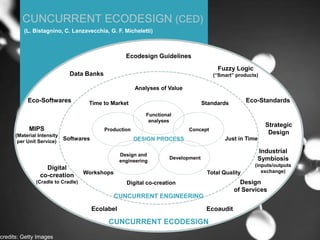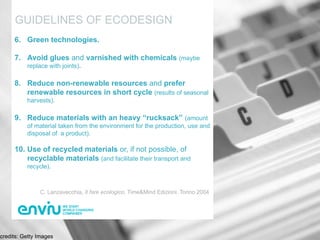Ecodesign to be prosumer workshop on ecodesign
- 1. Ecodesign to be prosumer Giulia Ferrari
- 2. Why Ecodesign? credits: Getty Images
- 3. Our goal The territory is inhabited by us, so we know exactly what that needs. To be PROSUMERS: aware of our choices and responsible towards environment. To educate to critical thinking, not just let us live, but to live. credits: Getty Images
- 4. CONTENT 1. Introduction 2. Concurrent (or Simultaneous) Ecodesign 3. Guidelines of Ecodesign 4. LetŌĆÖs be prosumer since now! credits: Getty Images
- 5. Introduction 5 credits: Getty Images
- 6. SUSTAINABLE DEVELOPMENT ŌĆó 1987, United Nations, Brundtland Commission: development that "meets the needs of the present without compromising the ability of future generations to meet their own needs.ŌĆØ ŌĆó 2011, Michael Thomas Needham: "as the ability to meet the needs of the present while contributing to the future generationsŌĆÖ needs.ŌĆ£ (There is an additional focus on the present generations' responsibility to improve the future generations' life). wikipedia.com credits: Getty Images
- 7. SUSTAINABLE DEVELOPMENT Scheme wikipedia.com credits: Getty Images
- 8. SUSTAINABLE DEVELOPMENT Scheme Systemic vision: economy exists inside the society and both exist in the natural environment. Economy Society Environment defined territory (local) credits: Getty Images
- 9. SUSTAINABLE DEVELOPMENT The Three EŌĆÖs Balance Rule ŌĆ£The Three EŌĆÖsŌĆØ: Equity, Economy and Ecology. (Agenda 21*) ŌĆó Equity: to take joint action, encouraged by consultation among the various levels of government, to ensure conditions for human well-being (safety, health, education) for all the people in the world. ŌĆó Economy: to produce and maintain the maximum added value within the territory, first exploiting actual resources. ŌĆó Ecology: to enhance and protect the environment as a "distinctive element" of the territory. *Agenda 21 is an action agenda for the United Nations , other multilateral organizations, and individual governments, with regards to sustainable development, product of the UN Conference on Environment and Development (UNCED) held in Rio de Janeiro, Brazil, in 1992. wikipedia.com credits: Getty Images
- 10. Concurrent Ecodesign 10 credits: Getty Images
- 11. CUNCURRENT ECODESIGN (CED) (L. Bistagnino, C. Lanzavecchia, G. F. Micheletti) ŌĆó Design methodology ŌĆó Includes the Cuncurrent Engineering (design of single products in a ŌĆ£eco wayŌĆØ) ŌĆó Organizational tool to deal with the management of complexity ŌĆó Goal: to pursue the sustainable development in a broad sense credits: Getty Images
- 12. CUNCURRENT ECODESIGN (CED) (L. Bistagnino, C. Lanzavecchia, G. F. Micheletti) Ecodesign Guidelines Fuzzy Logic Data Banks (ŌĆ£SmartŌĆØ products) Analyses of Value Eco-Softwares Time to Market Standards Eco-Standards Functional analyses Strategic MIPS Production Concept (Material Intensity Design per Unit Service) Softwares DESIGN PROCESS Just in Time Industrial Design and Development Symbiosis engineering (inputs/outputs Digital Workshops Total Quality exchange) co-creation (Cradle to Cradle) Digital co-creation Design of Services CUNCURRENT ENGINEERING Ecolabel Ecoaudit CUNCURRENT ECODESIGN credits: Getty Images
- 13. Guidelines of Ecodesign 13 credits: Getty Images
- 14. GUIDELINES OF ECODESIGN ŌĆó Ecodesign regards all the life cycle of a product, from ŌĆ£Cradle to CradleŌĆØ (Michael Braungart, Bill McDonough), from raw materials to production to waste management to reintroduction of waste as raw material. product/+service Cradle waste to resource ŌĆó We have to go beyond the appearance and understand its whole life cycle: a green product is not only that made of recycled or recyclable materials! credits: Getty Images
- 15. GUIDELINES OF ECODESIGN 1. Precycling: avoid the production of waste upstream. 2. ŌĆ£Cradle to cradleŌĆØ design. 3. Evaluation of the environmental impact of the product before its production. 4. Design for reduction: avoid oversize, reduce thicknesses and quantity of material, dematerialization, integrate more functions. 5. Optimization of energy consumption (in production and use). C. Lanzavecchia, Il fare ecologico, Time&Mind Edizioni, Torino 2004 credits: Getty Images
- 16. GUIDELINES OF ECODESIGN 6. Green technologies. 7. Avoid glues and varnished with chemicals (maybe replace with joints). 8. Reduce non-renewable resources and prefer renewable resources in short cycle (results of seasonal harvests). 9. Reduce materials with an heavy ŌĆ£rucksackŌĆØ (amount of material taken from the environment for the production, use and disposal of a product). 10. Use of recycled materials or, if not possible, of recyclable materials (and facilitate their transport and recycle). C. Lanzavecchia, Il fare ecologico, Time&Mind Edizioni, Torino 2004 credits: Getty Images
- 17. GUIDELINES OF ECODESIGN 11. Create production and consumption systems, respecting biodiversity, local cultures and human rights. 12. Industrial symbiosis: integrated factories (zero waste, zero emissions). 13. Reduce water consumption (in production and use). and use non-potable water for industrial uses. 14. Design packaging in parallel to product (to avoid further environmental costs in logistics). 15. Minimize transport consumption. C. Lanzavecchia, Il fare ecologico, Time&Mind Edizioni, Torino 2004 credits: Getty Images
- 18. GUIDELINES OF ECODESIGN 16. Replace products with corresponding services. 17. Minimize noises increasing less possible the quantity of insulating material. 18. Equal lifetime of components or partially replacement of them (maintenance and upgrade). 19. Modularity and standardization. 20. Mark materials and reuse ŌĆ£in cascadeŌĆØ (e.g.: in a car from the bumper to the dashboard to mats) C. Lanzavecchia, Il fare ecologico, Time&Mind Edizioni, Torino 2004 credits: Getty Images
- 19. GUIDELINES OF ECODESIGN 21. Long-life items, unless they are subjected to considerable technological upgrade and improvement towards sustainability. 22. Use a single material or compatible materials families or reduce the coexistence of different materials (screws and nails included). 23. Design for Assembly and Disassembly (if the previous is not possible). 24. Design for Components. C. Lanzavecchia, Il fare ecologico, Time&Mind Edizioni, Torino 2004 credits: Getty Images
- 20. LetŌĆÖs be prosumer since now! 20 credits: Getty Images
- 21. GREEN PRODUCTS ARE REALLY ECODESIGNED? ŌĆó Check books on green design products and reflect if they apply actually Ecodesign guidelines. ŌĆó Remember: not all products, which the market tell us are eco, are actually like that! The market lives of marketing and exploits values and ideas it wants through communication! credits: Getty Images
- 22. SOME PRODUCTS ARE ECODESIGNEDŌĆ”NOT INTENTIONALLY! ŌĆó Surf the web to find 2 products which apply one or more guidelines of Ecodesign (possibly different guidelines). ŌĆó Underline CED guidelines. ŌĆó Remember: be critical! credits: Getty Images
- 23. ŌĆ”and remember: not just let us live, but to live. credits: Getty Images























